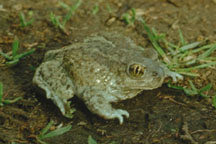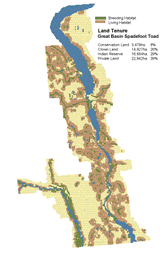|
Habitat Atlas for Wildlife at Risk
Great Basin Spadefoot Toad
Spea intermontana

Great
Basin Spadefoot Toad
|

- Spadefoots are distinguished from other frogs by
vertical "cat's
eye" pupils.
- Grey or tan with irregular vague stripes and blotches,
and small, round, red bumps.
- Wide, flat body and short legs, adults can reach
6 cm in length.
- The hind feet have a single, black, hard, spade-shaped
knob on the heel for digging.
- Light tan or grey hatchlings have a broad triangular
head, that appears to be distinctly separated from
the body.
- Tadpoles can reach 7 cm in length and are dark
with gold flecks forming a conspicuous 'Y' across
the body.
Status:
British Columbia Blue List
Canada: Vulnerable
Special Significance
The Great Basin Spadefoot Toad is at risk in British
Columbia because of its restricted distribution,
its dependence on specialized habitats of temporary
pools of water in dry regions, and loss of wetland
breeding habitat and grassland foraging habitat to
urbanization and intensive agriculture. Spadefoots
typically breed in small ponds that may dry up by
summer. Increased human and agricultural use is presumably
responsible for a reduced water table which impacts
this specialized toad habitat. While it is protected
from capture or killing under the British Columbia
Wildlife Act, its habitat remains unprotected. Landowners
can help to ensure the continued survival of this
amphibian by fencing breeding ponds, stopping stocking
of lakes and ponds with game fish, and retaining
wetlands and the natural vegetation around them.
Distribution
- In Canada, found only in British Columbia mainly in the Okanagan
Valley, also in the Kettle, Nicola, Thompson, and
Similkameen valleys.
- Marshes at the north end of Osoyoos Lake and the
Osoyoos sewage lagoons are key breeding sites.
- Spadefoot Toads are restricted to the bunchgrass
and ponderosa pine zones.
Habitat
- Adults breed in pond edges, marshes, slow moving creeks, stock
tanks, irrigation ditches and temporary pools of water.
- Spadefoots forage in dry shrub-grasslands and open
lower elevation forests.
- Toads require deep, loose soil for burrowing into during
daylight hours and during hibernation; they will
also use rodent burrows or burrow under rocks or logs.
Reproduction
- Breeding begins after rains in mid to late April, or as late as
July during cool, wet years.
- Females lay 300-500 eggs in water less than 50 cm deep;
egg clusters are often attached to submerged plants.
- Eggs hatch in 2 to 3 days in warm water, but can take
up to 7 days or more during cool weather.
- Tadpoles mature in 6 to 8 weeks and leave the breeding
area, but do not become sexually mature for 2 or
3 years.
- Toads return to hibernation sites in October.
Food Habits
- Adult toads eat ants, grasshoppers, beetles and crickets; they
forage at night, especially on rainy nights or nights with high
humidity.
- Tadpoles are scavengers on algae, aquatic plants, dead
fish and even their own feces; on occasion they
will eat each other.
Interesting Facts
- 'Spades' on their hind feet allow a toad to disappear from a site
in minutes!
- Spadefoots are one of the few desert adapted amphibians,
surviving drought by burying themselves and secreting
a protective gelatinous coat.
- Tadpoles can live in water that is as warm as 34°C.
- Call is a low-pitched quacking.
- Skin contains toxins which help protect it from predators.
Threats
- Population concentrated in a few large breeding
sites makes this species vulnerable to
drastic decline if land use changes at these sites.
- Livestock can trample banks of ponds and lakes
which crushes tadpoles and buried adults,
limits underground access for toads, degrades plant habitats
and lowers water quality.
- Filling and draining ponds and wetlands destroys
breeding habitats.
- Increasing irrigation and human water consumption
may lower the water table and reduce or
dry up small breeding pools.
- Extensive land development has degraded or
eliminated shrub-grassland foraging and
hibernating habitat.
- Road kills during migrations to and from breeding
areas.
- Introduced game fish in lakes and ponds compete
with toads for food or prey on toads.
Management Considerations
- Protect major breeding sites and surrounding
foraging habitat.
- Fence ponds and lakes to exclude livestock.
- Maintain water levels whenever possible.
- Create ponds to compensate for loss of natural
breeding habitat.
- Install culverts under roads and amphibian fences
along roads near areas with high numbers
of toads.
- Do not stock ponds or lakes with game fish.
|
References
1. Cannings, R. J. 1997. The status of the Great Basin Spadefoot
Toad (Spea intermontana) in Canada. Unpublished report, Committee
on the Status of Endangered Wildlife in Canada.
2. Corkran, C.C. and C. R. Thoms. 1996. Amphibians
of Oregon, Washington and British Columbia: a field identification
guide. Lone Pine Publishing. Vancouver, British Columbia.
3. Green, D.M. and R.W. Campbell. 1984. The amphibians
of British Columbia. British Columbia Provincial Museum Handbook No.
45.
|